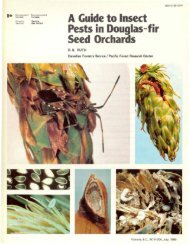the translocation of minerals in trees - Canadian Forest Service
the translocation of minerals in trees - Canadian Forest Service
the translocation of minerals in trees - Canadian Forest Service
Create successful ePaper yourself
Turn your PDF publications into a flip-book with our unique Google optimized e-Paper software.
on <strong>the</strong> fact that <strong>the</strong> liv<strong>in</strong>g cell is not <strong>in</strong> equilibrium with <strong>the</strong> environment (Ste<strong>in</strong>bach,<br />
1951). Concern<strong>in</strong>g this aspect, <strong>the</strong> studies <strong>of</strong> Epste<strong>in</strong> and Hendricks<br />
(1955) on ion transport <strong>in</strong> <strong>the</strong> roots <strong>of</strong> higher plants have shown that ions move<br />
freely <strong>in</strong>to and out <strong>of</strong> an "outer" space <strong>of</strong> <strong>the</strong> roots. This takes place by diffusion<br />
and exchange, <strong>in</strong>dependently <strong>of</strong> <strong>the</strong> simultaneous active transport <strong>of</strong> <strong>the</strong> same<br />
ions which results <strong>in</strong> <strong>the</strong>ir transfer <strong>in</strong>to an "<strong>in</strong>ner" space where <strong>the</strong>y are no<br />
longer exchangeable with <strong>the</strong> same or o<strong>the</strong>r ions. Epste<strong>in</strong> (personal communication)<br />
considers that <strong>the</strong>se <strong>in</strong>ner and outer spaces <strong>in</strong> <strong>the</strong> root do not represent<br />
dist<strong>in</strong>ct tissues but ra<strong>the</strong>r parts <strong>of</strong> cells. The outer space is <strong>in</strong>tracellular and is<br />
identified with <strong>the</strong> cytoplasm. S<strong>in</strong>ce entry <strong>in</strong>to and exit from this space is by<br />
diffusion, it develops that <strong>the</strong> outer membrane <strong>of</strong> cytoplasm is quite permeable<br />
to ions, and <strong>the</strong>refore is not <strong>the</strong> membrane which operates <strong>the</strong> active metabolic<br />
mechanism <strong>of</strong> ion transport. These exchange and diffusion processes are<br />
reversible, non-selective, non-metabolic, and come to equilibrium approximately<br />
with<strong>in</strong> an hour after immersion <strong>of</strong> <strong>the</strong> roots <strong>in</strong> a new solution. Kramer and<br />
Wiebe (1954) noted that <strong>the</strong> meristematic region <strong>of</strong> <strong>the</strong> roots accumulates large<br />
amounts <strong>of</strong> <strong>m<strong>in</strong>erals</strong> but very little is translocated from it to o<strong>the</strong>r parts <strong>of</strong> <strong>the</strong><br />
plant. They concluded that most <strong>of</strong> <strong>the</strong> <strong>m<strong>in</strong>erals</strong> translocated out <strong>of</strong> <strong>the</strong> roots<br />
are absorbed by <strong>the</strong> root-hair zone, or region <strong>of</strong> differentiation.<br />
RELATIVE ROLES OF XYLEM AND PHLOEM IN TRANSLOCATION<br />
There has been conflict<strong>in</strong>g evidence as to <strong>the</strong> relative roles played by xylem<br />
and phloem <strong>in</strong> <strong>the</strong> up\vard <strong>translocation</strong> <strong>of</strong> <strong>m<strong>in</strong>erals</strong>. Some physiologists<br />
(Curtis and Clark, 1950) do not consider any difference <strong>in</strong> <strong>the</strong> mechanisms <strong>of</strong><br />
transport <strong>of</strong> <strong>in</strong>organic and organic substances, except that <strong>the</strong> latter are more<br />
usually transported and required by different parts <strong>of</strong> <strong>the</strong> plant <strong>in</strong> larger amounts.<br />
Curtis (1925) found removal <strong>of</strong> <strong>the</strong> bark (r<strong>in</strong>g<strong>in</strong>g) would <strong>in</strong>terfere with <strong>the</strong><br />
upward transfer <strong>of</strong> solutes. In his experiments, divided stem were used, \\'here<br />
water was supplied to <strong>the</strong> top by one set <strong>of</strong> roots and nitrogen by ano<strong>the</strong>r set.<br />
Results <strong>in</strong>dicated that if <strong>the</strong> roots supplied with nitrogen were connected to <strong>the</strong><br />
tops by xylem only, <strong>the</strong>re was little transfer <strong>of</strong> nitrogen, while if <strong>the</strong>y were<br />
connected by phloem only, considerable transfer occurred. Diffusion alone<br />
could not account for this rapid movement, and Curtis thought that protoplasmic<br />
stream<strong>in</strong>g with<strong>in</strong> <strong>the</strong> cells may have been a factor.<br />
Evidence show<strong>in</strong>g that <strong>the</strong>re is no direct relation between water absorption<br />
and salt absorption was given by Muenscher (1922) <strong>in</strong> his work on <strong>the</strong> effect <strong>of</strong><br />
transpiration on· ab orption <strong>of</strong> salts by plants. Mason, Maskell, and PhiJIis<br />
(1936) verified this work and mentioned that oxygen deficiency, <strong>in</strong>duced locally,<br />
could reduce transport, but not always, s<strong>in</strong>ce <strong>the</strong> transpiration stream may carry<br />
enough oxygen.<br />
It is considered that <strong>m<strong>in</strong>erals</strong> can move upward through <strong>the</strong> phloem,<br />
especially if <strong>the</strong> leaves have not expanded. There are conflict<strong>in</strong>g observations<br />
on <strong>the</strong> importance <strong>of</strong> <strong>the</strong> phloem <strong>in</strong> upward transport from roots to leaves.<br />
Stout and Hoaglund (1939), us<strong>in</strong>g radioactive tracers, found that when <strong>the</strong><br />
xylem and phloem were separated, upward transport took place almost entirely<br />
<strong>in</strong> <strong>the</strong> xylem. Curtis and Clark (1950) compared <strong>the</strong>se negative results for<br />
phloem transport with <strong>the</strong> positive results <strong>of</strong> Biddulph and Markle (1944).<br />
The latter authors allowed <strong>the</strong>ir plants to stand overnight to recover from <strong>the</strong><br />
shock <strong>of</strong> hav<strong>in</strong>g <strong>the</strong> phloem separated from <strong>the</strong> xylem and <strong>the</strong>y found phosphorus<br />
movement upward and downward through <strong>the</strong> phloem.<br />
It is probable that ei<strong>the</strong>r phloem or xylem alone can transport <strong>the</strong> required<br />
<strong>m<strong>in</strong>erals</strong>. Curtis and Clark (1950) summarize m<strong>in</strong>eral transport thus: "that<br />
<strong>the</strong> xylem is concerned with m<strong>in</strong>eral transport more (1) <strong>in</strong> herbaceous plants<br />
than <strong>in</strong> woody; (2) <strong>in</strong> those plants show<strong>in</strong>g active root pressure than <strong>in</strong><br />
those without root pressure; (3) near <strong>the</strong> base <strong>of</strong> <strong>the</strong> plant than <strong>in</strong> <strong>the</strong><br />
6



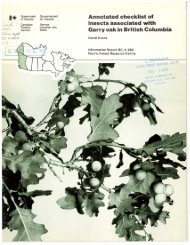
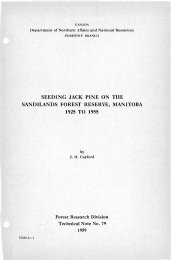
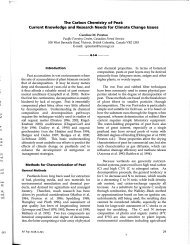


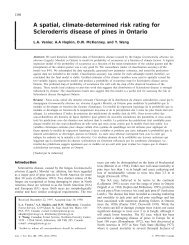

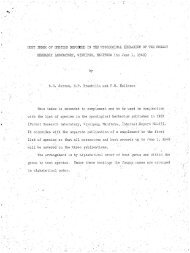
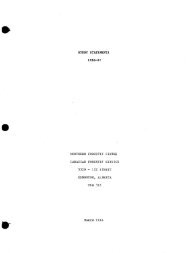
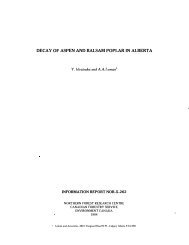
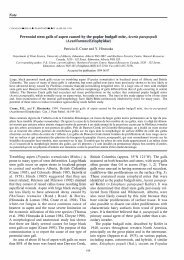
![Po],rell](https://img.yumpu.com/11946277/1/190x231/porell.jpg?quality=85)
